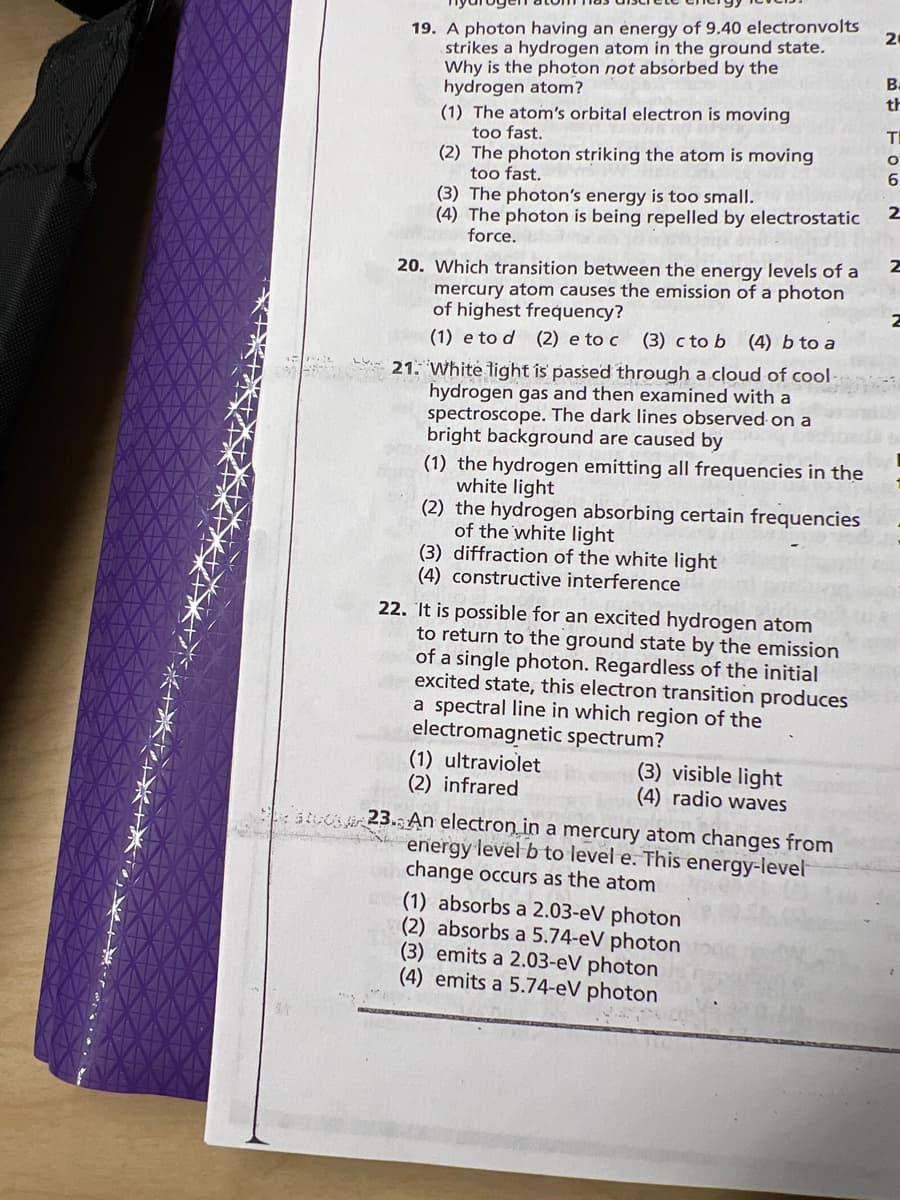19. A photon having an energy of strikes a hydrogen atom in the Why is the photon not absorbe hydrogen atom? (1) The atom's orbital electron too fast. (2) The photon striking the atc too fast. (3) The photon's energy is too (4) The photon is being repelle force. 20. Which transition between the mercury atom causes the emissi of highest frequency? (1) e to d (2) e to c (3) c to 21. White light is passed through a hydrogen gas and then examin spectroscope. The dark lines ob bright background are caused (1) the hydrogen emitting all fr white light (2) the hydrogen absorbing cer of the white light (3) diffraction of the white ligh (4) constructive interference 22. It is possible for an excited hydr to return to the ground state b of a single photon. Regardless c excited state, this electron trans a spectral line in which region electromagnetic spectrum? (1) ultraviolet (2) infrared (3) visil (4) rad di 23. An electron in a mercury atom energy level b to level e. This er change occurs as the atom (1) absorbs a 2.03-eV photon (2) absorbs a 5.74-eV photon (3) emits a 2.03-eV photon (4) emits a 5.74-eV photon
19. A photon having an energy of strikes a hydrogen atom in the Why is the photon not absorbe hydrogen atom? (1) The atom's orbital electron too fast. (2) The photon striking the atc too fast. (3) The photon's energy is too (4) The photon is being repelle force. 20. Which transition between the mercury atom causes the emissi of highest frequency? (1) e to d (2) e to c (3) c to 21. White light is passed through a hydrogen gas and then examin spectroscope. The dark lines ob bright background are caused (1) the hydrogen emitting all fr white light (2) the hydrogen absorbing cer of the white light (3) diffraction of the white ligh (4) constructive interference 22. It is possible for an excited hydr to return to the ground state b of a single photon. Regardless c excited state, this electron trans a spectral line in which region electromagnetic spectrum? (1) ultraviolet (2) infrared (3) visil (4) rad di 23. An electron in a mercury atom energy level b to level e. This er change occurs as the atom (1) absorbs a 2.03-eV photon (2) absorbs a 5.74-eV photon (3) emits a 2.03-eV photon (4) emits a 5.74-eV photon
Related questions
Question
This is a multiple choice question so you can just give me the letter of the answer. This is one question with 5 parts so it is not against guidelines to answer all 5 parts.

Transcribed Image Text:19. A photon having an energy of 9.40 electronvolts
strikes a hydrogen atom in the ground state.
Why is the photon not absorbed by the
hydrogen atom?
(1) The atom's orbital electron is moving
too fast.
(2) The photon striking the atom is moving
too fast.
(3) The photon's energy is too small.
(4) The photon is being repelled by electrostatic
force.
20
B.
th
TI
20. Which transition between the energy levels of a
mercury atom causes the emission of a photon
of highest frequency?
(1) e to d (2) e to c (3) c to b (4) b to a
* 21. White light is passed through a cloud of cool
hydrogen gas and then examined with a
spectroscope. The dark lines observed on a
bright background are caused by
(1) the hydrogen emitting all frequencies in the
white light
(2) the hydrogen absorbing certain frequencies
of the white light
(3) diffraction of the white light
(4) constructive interference
22. It is possible for an excited hydrogen atom
to return to the ground state by the emission
of a single photon. Regardless of the initial
excited state, this electron transition produces
a spectral line in which region of the
electromagnetic spectrum?
(1) ultraviolet
(2) infrared
(3) visible light
(4) radio waves
sir 23. An electron in a mercury atom changes from
energy level b to level e. This energy-level
change occurs as the atom
(1) absorbs a 2.03-eV photon
(2) absorbs a 5.74-eV photon
(3) emits a 2.03-eV photon
(4) emits a 5.74-eV photon
Expert Solution
This question has been solved!
Explore an expertly crafted, step-by-step solution for a thorough understanding of key concepts.
This is a popular solution!
Trending now
This is a popular solution!
Step by step
Solved in 2 steps
